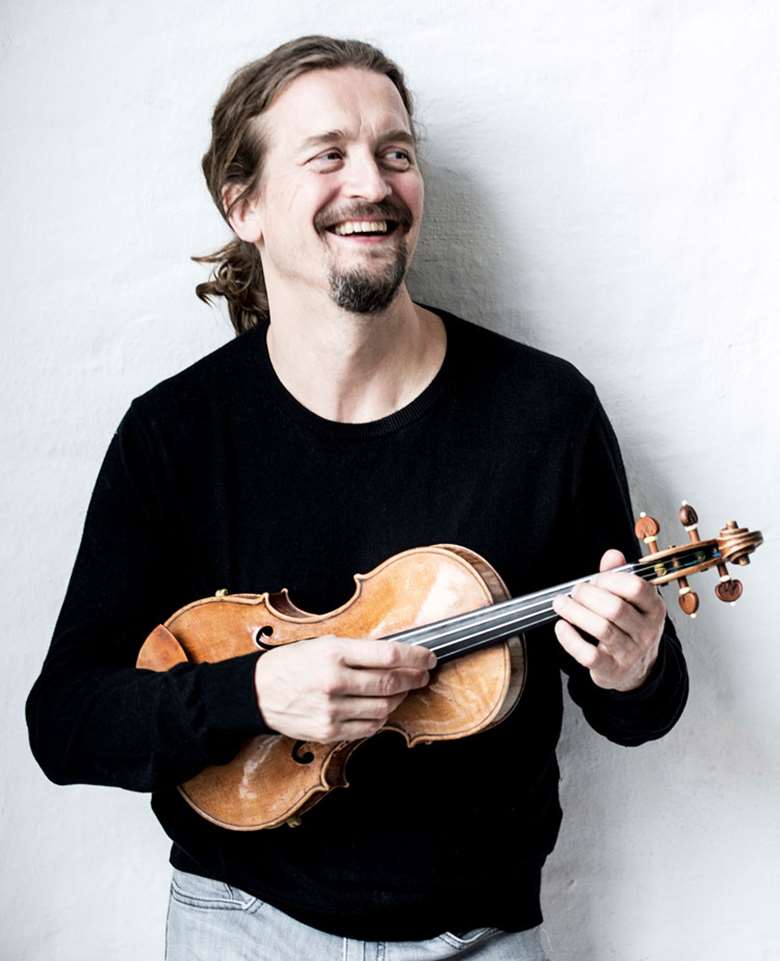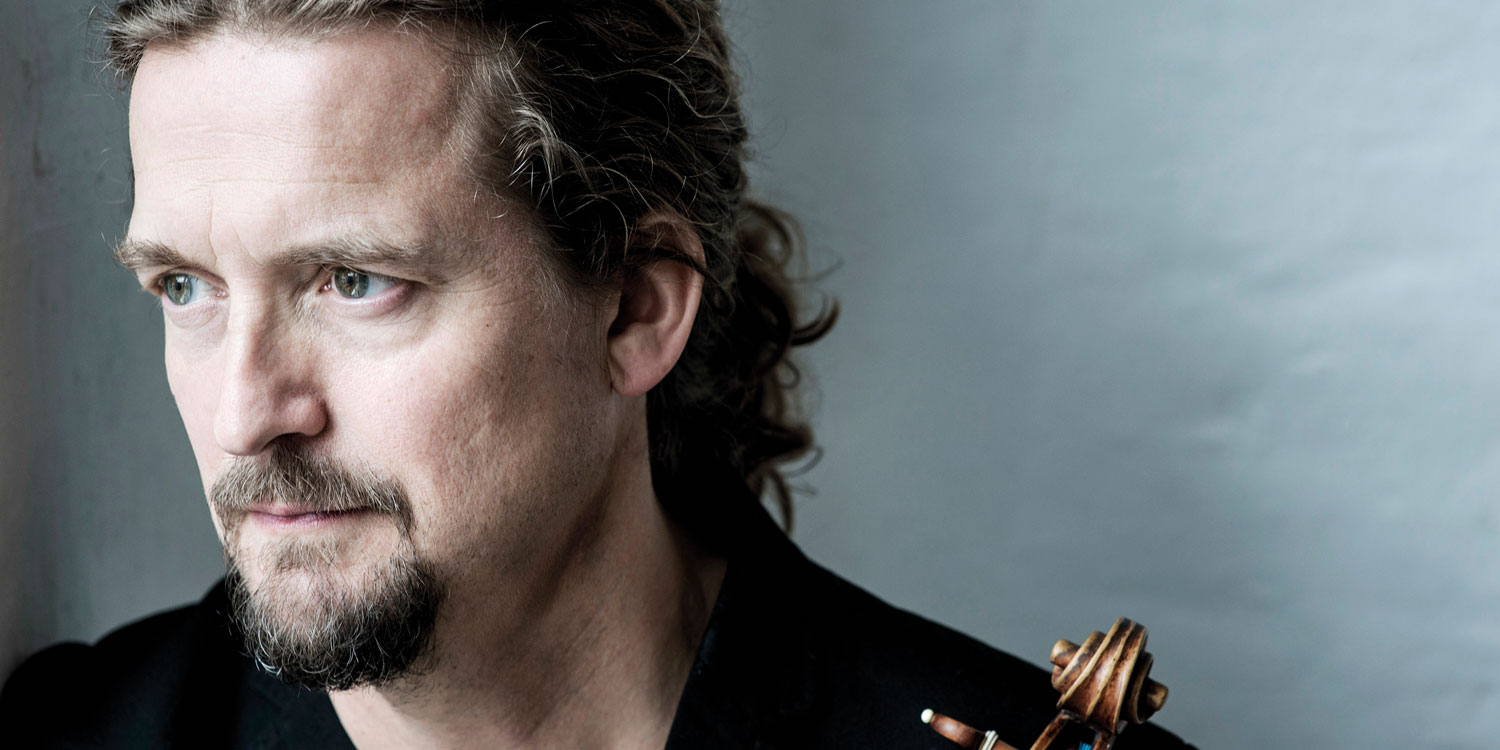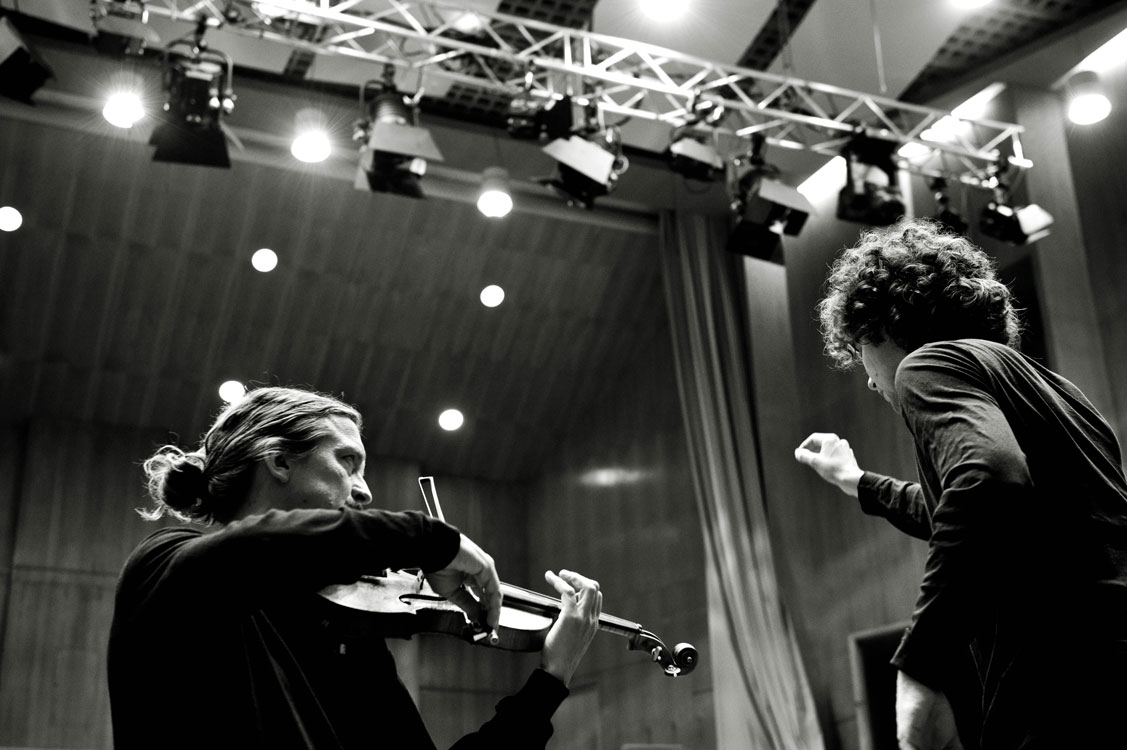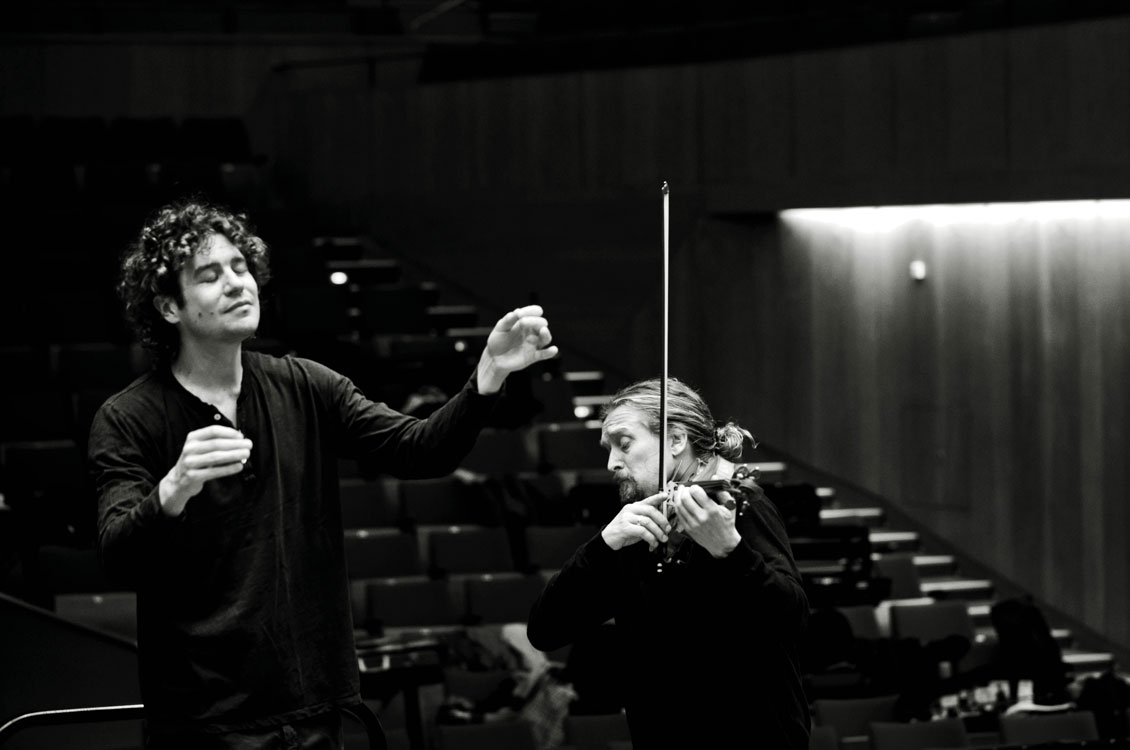Christian Tetzlaff: ‘I think Sibelius did for his century what Beethoven did for his’
James Jolly
Monday, November 4, 2019
As Christian Tetzlaff returns to the Beethoven and Sibelius violin concertos, James Jolly finds out why he’s considered one of the greatest violinists of our time

For the conductor Paavo Järvi, there are two kinds of soloist: ‘Those who leave after they’ve played their concerto and meet you later for dinner. And then there are the people who always take the opportunity to listen to the symphonic work in the second half. And Christian is one of those. He has a profound interest in music – not just violin music – but music in general. It sounds like that should be very normal but it’s not.’ And, as if to prove Järvi’s point, who should be sitting in front of me in Berlin’s Philharmonie a few weeks later for Rachmaninov’s Second Symphony, having just given an extraordinary performance of Beethoven’s Violin Concerto, but Christian Tetzlaff.
That performance of the Beethoven, recorded live over two nights, is released this month by Ondine, partnered by Sibelius’s concerto; both are with Robin Ticciati conducting the Deutsches Symphonie-Orchester Berlin. Conductors clearly love working with Tetzlaff. ‘He’s constantly showing me, teaching me,’ Ticciati says. ‘Hearing him in the Schumann or Brahms sonatas with Lars Vogt, I feel I’m getting a whole new vocabulary of music. It has changed me a lot. And I’m completely obsessed by his trio with his sister Tanja and Lars.’ And Järvi says, unequivocally, ‘He’s one of the greats. He’s totally on top form – totally. You learn from him – you hear him talk through the music rather than just play the notes. He doesn’t do formula.’
‘Christian always comes from the core of the music and that’s ultimately so satisfying and so much fun’ – Lars Vogt
For the pianist and conductor Vogt, one of the violinist’s closest friends and a musical partner for some 30 years, Tetzlaff ‘just knows everything, and understands everything. He has a background knowledge like no one else. Having been so close over so many years, I think we’ve influenced each other a lot. Where I originally came from was a kind of gut music-making – what felt good to me – and he came completely from the opposite direction: he’s very reflective. So often, we musicians go for what comes across better, and makes us look better. Christian always comes from the core of the music and that’s ultimately so satisfying and so much fun. I’ve learnt a lot from his approach: what does anything a composer write mean? What does it mean stylistically? What did it mean at the time? I’ve had fantastic teachers and conductors who I’ve learnt so much from, but there’s no one I’ve learnt more from than Christian.’
Tetzlaff, now 53, has been performing at the highest level for three decades (a Christoph von Dohnányi-conducted Cleveland Orchestra performance, when Tetzlaff was 22, of the Schoenberg Violin Concerto was a major career milestone), yet he wears his position as one of the world’s leading violinists very lightly. He’s not interested in the trappings of fame or success. What you see, as Järvi points out, is what you get. ‘He’s someone who has a very happy family life,’ he says. ‘He’s absolutely true to himself and there’s a complete honesty to his music-making.’ Tetzlaff’s shoulder-length hair, worn tied back when he plays, and his relaxed concert attire, hint at a man who is completely comfortable in his own skin. Based in Berlin, he has a young family – aged six, four and two – with a new partner, the Italian photographer Giorgia Bertazzi, and one senses that family plays an enormously important part in his life, on a par with music. ‘He has changed, in my opinion, in a fantastic direction,’ says Järvi. ‘He plays the way he looks now – he has stopped worrying about how others think and has his own way. He’s so super-intelligent. He was always a wonderful example of how one could combine a family life and a professional life. He’s a very dedicated and loving person– and he’s really funny. He has a fantastic sense of humour!’

Christian Tetzlaff (photo: Giorgia Bertazzi)
At about the same time that Tetzlaff started his new life in Berlin (he’d previously lived in Frankfurt with his first wife with whom he has three children), he also embarked on a new recording relationship with Ondine. And Ondine’s Reijo Kiilunen couldn’t be happier with the partnership, which has brought numerous rapturous reviews and plentiful awards (including Gramophone’s Concerto Award last year). ‘It started back in 2010’, says Kiilunen, ‘when I learnt that Christian had recorded the Mendelssohn and Schumann concertos and that there was no label yet for the recording. So I jumped in and luckily managed to get it for Ondine. As a record collector I’d been a great fan for a long time. And then we got talking and Christian said he was working a lot with Lars Vogt, and as I was keen to continue the partnership, it just started from there. He offers so many possibilities – duo work with Lars, concerto recordings, solo recordings and he has his own trio and quartet. So I was thrilled to have him on board. I really do think he’s one of the greatest violinists of our time.’
Tetzlaff has a total horror of routine or any kind of fixed approach to the works he plays. When The Telegraph’s Ivan Hewett asked him in 2011 if he was concerned about the dangers of staleness creeping in when he revealed he’d played the Brahms concerto 33 times in recent years, his sense of shock was obvious: ‘Why? The piece isn’t getting any worse. And every time it’s a new audience, who have to be taken on this fantastic journey.’ As Järvi points out, ‘What I like is that Christian has an incredibly strong opinion and point of view – not an opinion that comes from habit (“Here I do a rallentando” – we never talk about that sort of thing because that’s part of natural music-making, we’re in touch musically and it just happens), but there is a conceptual point of view about which he’s very passionate. And that’s what you look for from him. I have done the same piece with him enough times to see those conventions also change. Certain things become less important to him, certain things more. It’s great. So often, conducting soloists becomes a kind of servicing, which is the worst possible situation to be in, a sort of cat-and-mouse game where you’re trying to ensure everything is comfortable. And you don’t have any real interaction. With Christian it’s totally about interaction and making music in the moment. One thing with him is that he’s prepared to take huge risks in concert, and risks are fantastic, but they are exactly that: risks. And what I like is that he does things for the emotion of it rather than to be safe.’

Christian Tetzlaff and Robin Ticciati
Beethoven wrote his only Violin Concerto in 1806 and though it was not particularly successful at its Vienna premiere, it was revived in the 1840s by a 12-year-old Joseph Joachim with Mendelssohn conducting. It quickly secured its position at the heart of the violin-concerto repertoire, and the genre – as so often is the case with any that Beethoven touched – was raised to a new level: a classical medium so gracefully done by Haydn and Mozart had been taken and given an almost symphonic ambition (its 25-minute first movement could comfortably accommodate the whole of Mozart’s Third Violin Concerto, for example). Sibelius, an accomplished violinist (which Beethoven was not), wrote his sole concerto in 1904, almost exactly 100 years after the Beethoven, and revised it the following year to give us the version we invariably hear today. ‘I’m sure Christian is fascinated by the fact that these are two pieces that are totally alone, isolated peaks,’ Ticciati suggests.
The Beethoven and Sibelius violin concertos have seldom been coupled on a recording before. ‘You can either go for the old Monty Python “And now for something completely different” approach,’ says Tetzlaff, ‘or you can start searching. I find enough to make the pairing plausible. They both come from the beginning of new centuries, they’re both Janus-like. Beethoven is firmly in the Haydn-Mozart tradition, but also looking ahead in a completely different way. And for me the Sibelius is the same. He’s a very modern composer in his intentions. A few days ago, here in Berlin, we played his Voces intimae String Quartet, and that’s a wild piece. In the Fourth Symphony’s first movement he goes atonal, but that’s not his trademark, and it is not the only thing that defines him as a modern composer. But structurally, yes, he’s still rooted in the Romantic tradition and yet looking forward into the new century. So I think both composers have a similar function – very different from Brahms, who really expanded the Beethoven concerto model. I think Sibelius did for his century what Beethoven did for his.’
‘Going for an obsessive approach is the only way to convey the danger and emotions Sibelius describes in his concerto’ – Tetzlaff
Tetzlaff has recorded both the Beethoven and Sibelius concertos before – in fact, this is his third version of the Beethoven having been partnered by Michael Gielen and the SWR SO Baden-Baden in 1988 and by David Zinman and Zurich’s Tonhalle Orchestra in 2005. His first Sibelius dates from 2002, one of his last recordings for Virgin Classics – the company that initially spotted his huge potential; ‘Here is a reading which, in its no-holds-barred fervour, reminds me more than most of the wild theatricality and solo fireworks one encounters in the Concerto’s original version,’ wrote Andrew Achenbach back in April 2003. What links the three performances of the Beethoven, though (and indeed every live performance he’s ever given), is the use of Beethoven’s own cadenza for his piano transcription of the concerto, ‘retro-fitted’ for the violin and employing the timpani. ‘Often a cadenza can be totally unrelated to the piece and quite often uses harmonies that are wrong because they are from a completely different time,’ Tetzlaff explains. ‘What Kreisler does is beautiful but a bit silly in playing all the melodies – and he even quotes the second subject. So it makes sense to me that if you have Beethoven’s cadenzas, you should use them. I think the bitterness of some aspects of the first movement are brought out by the use of this cadenza. The military feel is pushed even more with the use of the timpani. So the cadenza is a further explanation of the nature of the piece and not a display of virtuosity.’
Very striking in the two Berlin concerts – and very faithfully carried over onto the new recording – is not only how well this cadenza fits the first movement’s dramaturgy but also how it helps generate the momentum to propel the movement to its conclusion, a conclusion that surely demands some kind of applause. Laughing, Ticciati recalls a performance with the Chamber Orchestra of Europe in Rotterdam: ‘I do remember the performance, but what I remember more is Roger Federer bringing his mum round afterwards!’ Tetzlaff picks up the story: ‘I remember Federer coming up to me and saying “Very well done, but why did nobody clap after the first song?” And that is so right, on so many levels, because if there’s no clapping after the first movement, maybe you’ve done something wrong. The audience can be too well educated, because what Beethoven goes for is an explosion at the end of the first movement.’
‘I think a lot of so-called tradition comes from laziness’ – Tetzlaff
One word that often crops up in reviews of Tetzlaff’s performances, whether live or recorded, is ‘spontaneous’. No two performances are exactly the same, as Järvi has said, but there’s more to it than an on-the-wing creativity – there’s also a fearlessness. As Järvi puts it, ‘A lot of players have this fear that if they don’t project, somehow people will think they have a small sound, or don’t have a good violin; and they have a whole complex of beliefs about how a violinist should appear … He doesn’t care about that stuff.’ And when I ask Tetzlaff about the striking range of dynamics that he employs in the Beethoven, suggesting that perhaps his passion for chamber music plays some role, his answer is direct: ‘No, it emerges from looking at the music. I think a lot of so-called tradition comes from laziness. The first movement is written piano explicitly for the solo violin. And that is totally right so that the outbursts work properly in the right places. And I also know that anyone who has the conviction can play pianissimo and can feel at home. It’s simply about wanting the audience to open their ears and participate. When it gets really soft, the audience has to participate, to actively listen. When it’s loud, it’s done to you. Those are the best moments: when everything comes together in beauty and its ability to touch people. In the big concertos, if you look at the score and listen to what is done, they match in only every 30th bar. That comes from the idea that in the solo repertoire the artistic freedom of the soloist is paramount, that he has to dominate the orchestra and be the most important thing. And that’s silly because a great composer like Beethoven or Brahms uses all his craft and inner life in the same way in a solo concerto as in a string quartet. There are so many passages in both the Beethoven and the Brahms concertos where you have to accompany, for example, the oboe. And that’s where it becomes real fun. A soloist standing in front of the orchestra expecting 100 people to follow them I find ridiculous most of the time. It’s just about the soloist talking about themselves and frankly we have much nicer things to talk about!’
Tetzlaff’s ability – and willingness – to play very quietly was just one of the things that attracted Kiilunen: ‘What I really admire about his playing is how he makes time stand still in piano and pianissimo. Yet even behind these most fragile moments and sensitive pianissimos there’s this incredible intensity to his playing.’ Take the opening of the Sibelius, which stunned Ticciati when he first heard Tetzlaff play it: ‘So many people approach that first line like the waters have frozen over – it’s glacial. But what does the score say? Mezzo forte, dolce ed espressivo. It’s like a folk song, and that’s the feeling he goes for. There’s no end to how faithful he can be to the score. It forces everyone into a place where you just have to take a risk. What was it that Colin Davis use to say? … “When you’re recording live, there’s no second chance.” And with Christian that happens every time. It’s just so live.’ Vogt concurs: ‘About his pianissimos, you often find yourself saying that he can’t dare go even softer, and yet he does, and the sound hangs on by a hair. I’m always amazed by his courage for fragility, this courage to seek “non-beauty”. Music isn’t all about beauty – it has the entire range of expression. So, this whole idea that this is how violinists are supposed to sound – he doesn’t give a damn!’

Christian Tetzlaff and Robin Ticciati
Even though chamber music accounts for about 30 per cent of Tetzlaff’s concert life, it brings to his playing another dimension that violinists who only stick to the concerto repertoire are denied. Vogt believes it brings an entirely different mindset, one that turns its back on the ‘I’m the star and I have to be at the centre of things’ way of thinking. Tetzlaff himself explains further: ‘This idea that chamber music is just generally more cultivated, less soloistic and easier is ridiculous – the idea that those who don’t make it to solo work have to fall back on chamber music as if it is some kind of easy option. If I think about what I played last week when we did Beethoven’s Op 130 with the Grosse Fuge … The violin part is vastly more difficult than the Beethoven concerto and it’s way more taxing to play a programme with a Beethoven quartet, a Bartók quartet and a Mozart quartet – the technical challenges are huge.’
When Tetzlaff came to record the Sibelius concerto, it was his first studio concerto recording in nearly 20 years, and perhaps that extra experience of playing chamber music helped because, as he says, ‘Making the connection within the orchestra is so important – “Who hands the melody over, and to whom do I hand it back?” If it only goes through the conductor then it will not be free. A conductor who doesn’t listen to the players, doesn’t guide them to connect with the soloist, is diminishing this sense of freedom.’ He speaks of a kind of ‘love triangle’ that functions in an ideal concerto performance between soloist, conductor and orchestra. ‘Hopefully you will hear that we go on a journey, especially in the orchestral parts, that respects all of Sibelius’s markings; and for me, in the violin part, it is a very modern piece in the sense that the composer gives lots of extravagant shadings and markings. There are diminuendos on long, strong notes so that I always fade with the orchestra. It reminds me of the acting in early black-and-white silent movies, with the totally expressive faces changing dramatically because there are no words. And this is what Sibelius gives us in the first movement. We go for this obsessive approach because I think that’s the only way to convey the danger and out-of-the-ordinary emotions that he describes in this piece.’
Watching the Deutsches Symphonie-Orchester Berlin play a concerto is to see numerous examples of quasi-chamber interaction: the first desk of cellos leaning forwards to engage with the soloist, or the solo oboe looking directly at him during those moments of dialogue, a perfect example of that ‘love triangle’ Tetzlaff refers to. During the sessions for the Sibelius, where the only audience were the orchestra’s Intendant and Tetzlaff’s wife, Tetzlaff recalled that discussions with players went far beyond the notes on the page. ‘With Robin,’ Tetzlaff comments, ‘even though we are from different generations and different backgrounds and have different personalities, we have exactly the same language and luckily this works so well with his orchestra. So there were wonderful things like instead of saying, “Could we just play the F major a tiny bit louder, and the D minor a bit softer,” it was “This is a moment of hope,” or, “A shadow falls over this feeling of hope” – and it worked! And everyone knew how “hope” should sound! Or how the disappointment of the next section should feel. This is how we talked in the rehearsal, and it’s so comforting to know that what we are playing is not about the realisation of dynamics but about expressing a very specific quality of emotion. I feel that because of this, Robin and I are like Siamese twins – we have this innate understanding. It made doing the Sibelius and the Beethoven such a joy.’
This article originally appeared in the October 2019 issue of Gramophone. Never miss an issue of the world's leading classical music magazine – subscribe today!







